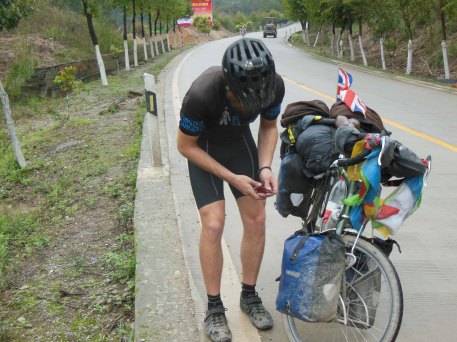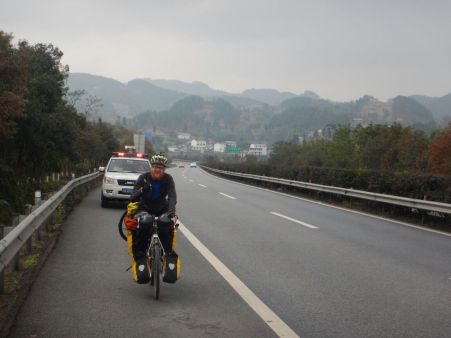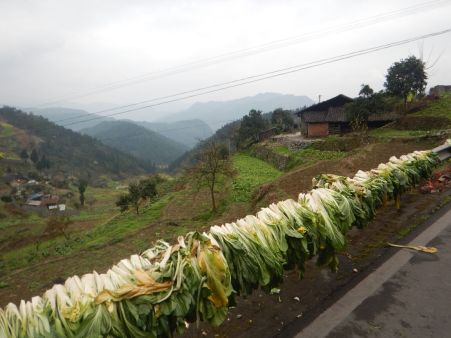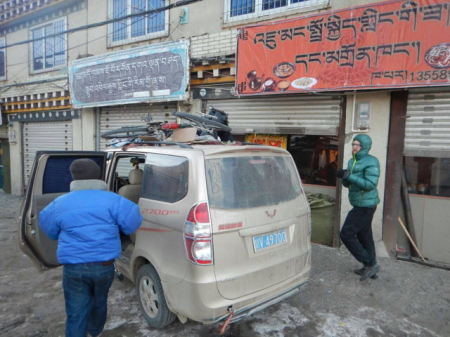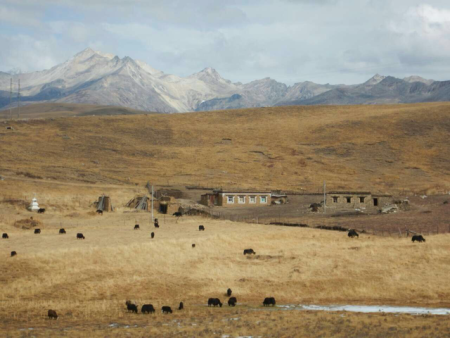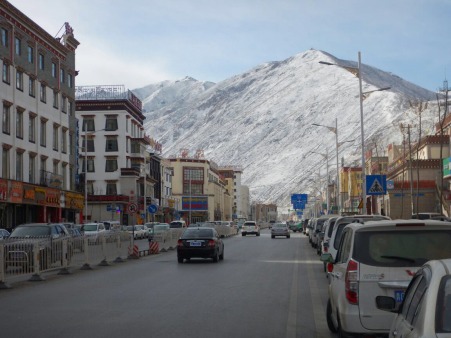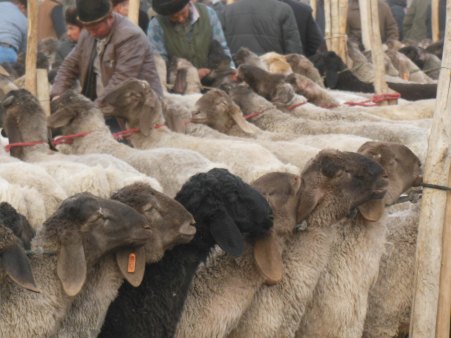It is already difficult to remember the details of our last section through the Pamirs. I think I’ve forgotten the tough times and what is left is a fantastical world of snowflakes, tinsel and Christmas merriment. Far from the truth! The scenery for our last week in the mountains was ridiculous, but unfortunately so were the conditions we faced, a long series of snowy climbs, wind and altitude. I’ve tried below to sum up our Pamir exit through Kyrgyzstan, and our entry into China on 29th December.
We left Murghab in very high spirits on December 23rd, having miraculously managed to find tinsel in the market the night before. The town is majority Kyrgyz despite still being in Tajikistan, and the market consisted of a few dozen big truck containers whose insides had been converted into small shops. Quite a desolate sight for a desolate town! Dawn on our departure day saw us attaching the glittery stuff onto the front of our handlebars, all done to Christmas music played out on our small speakers. The overwhelmingly Muslim Murghabians didn’t know what to make of this, but we smiled and waved and seemed to get away with it. Pushing off we quickly left the valley behind and headed due north.

Tinsel in Murghab

Riding through the plains out of Murghab
Here it is quickly worth mentioning that both of our tummies had festively decided to go on strike, and continued to do so until we reached China. We were usually given just moments’ notice before one of us had to dismount and sprint off to relieve himself. The added fun to this challenge was that we were on a plateau: as the name suggests there was very little cover to find on our sprints, so more often than not we were stuck with our trousers down in full view of the road. We called these stops ‘danger stops’, as despite the lack of traffic (maybe 2-3 cars per day), there was always that tiny chance – longed for by the person waiting with the bikes – that a truck would come over the hill and get more British backside than he had ever wished to see. However these wilderness relief stops were usually far safer than using designated loos when we did stop for the evening: the hole in the ground was more of a suggestion than a target, the centre of a urinary skating rink surrounded by frozen sculptures of human and animal waste.
Our slow climbs over the next week were punctuated by frequent breathing stops as well as Lobby’s boxing bouts to get the circulation back into his fingers. We had embarked on the toughest Central Asian section of the expedition, which had us up four high passes in six days. It’s safe to say that we struggled through it by holding up Kashgar as the Grail, where there would finally be good food, electricity, running water and generally all the things which Tajikistan lacked. China was practically within touching distance. In the mornings our beards would freeze and stay frozen all day, our faces transformed into one unhappy icicle. We both lost the feeling in our toes for large parts of the day, despite being in winter boots over our ski trousers. We still haven’t completely got the feeling back in our toes. Thankfully although the mountains were all snow-covered we had no actual snowfall to deal with yet as Pamir weather is extremely dry – instead blue skies summoned unprecedented cold which seemed to bite through our thermals. Things were quickly getting out of hand. I realised this as I tried to brush my teeth one morning and found that the bristles of my toothbrush had frozen together from two bags deep inside my pannier. Our water would freeze within short minutes of being out in the open. We made a habit of cycling with batteries taken out of all our electronics and put these next to our skin to stop them from freezing too. Temperature readings from the warmth of our panniers came to -15C, but it was -30C outside during the daytime. The expedition had definitely taken on a survival aspect, and it was all about pushing through to the Grail.

How cold is it?!
Our first climb was to Akbaital Pass (4655m), which was going to be the highest point of the expedition so far. It was manageable until we both hit a wall of tiredness in the late afternoon, at an altitude of 4200m. We had only cycled 70km that day so we were surprised at this relatively early exhaustion. It was like someone had drugged the thin air and replaced it with black dots and stars which twinkled in front of our drooping eyelids. Keeping the pedals going was a supreme effort, summoning all of our willpower, as well as requiring many, many Snickers, the booster fuel which supplied us with morale and energy all through the Pamirs. The temptation to lie down in the snow for an afternoon snooze was nearly overwhelming, so we rode side by side to make sure neither of us slid off the handlebars. At several points one of us shut our eyes on the saddle to be jabbed back to attention by the other. Neither of us fell asleep at the same time so we just about remained on the road! Teamwork. Later I had to wonder how I thought I would be getting to China curled up in the foetal position on the side of the road, but unfortunately at the time our thinking wasn’t too clear. We crawled up the icy path until finally we saw a cabin on the left, which we sprinted towards at a slow walking pace until our lungs gave out and we collapsed in a heap on the doorstep.

The Ak-baital road maintenance hut
We spent the first hour of our evening lying side by side on the floor next to the fire, trying to work out what had just happened. Being in a horizontal position somehow seemed to keep the brain ticking over, which threatened to shut down if it was forced vertically too abruptly. We were completely shattered. This greatly amused our host family who were used to living with basically no oxygen in the air and snickered at us, big foreign semi-corpses which now littered their central room. Our hut was a road maintenance post, part of a tiny network of workmen who kept the roads clear from snow, and were therefore forced to stay high in the mountains during the winter. We stayed in a number of these kinds of places during our last stretch of the Pamirs, as their huts had been pinpointed on our map as the only inhabited buildings left in the area. In practice the workmen didn’t seem to do much actual roadwork unless it snowed heavily (which was rare) so they lived out their winter days in the one heated room of their small hut. Small kids played around them and I wondered what it must be like for a four year old to be cooped up in one room for six months of the year. Our family in Akbaital was very kind, and our drugged state clearly seemed to provide intense amusement, so it was a good situation for both parties. The husband told us that it would get down to -45C overnight, and that we shouldn’t stray from the entrance after dark because of the wolves. He added the second bit as an afterthought, as if he knew looking down on us on the floor that we wouldn’t be straying far that evening.
We summited the next day, a slow three hour push as the gradient steepened and the path had turned to treacherous ice overnight. It was cold enough that the LCD screens on our odometers would stop working now and again, freezing at a certain display. It was then that I found out my odo’s minimum speed to register the wheel turning, which was 1.8kph. If we pushed more slowly than that, the display would read 0kph, which I can tell you is quite depressing when you’re dragging a laden bike up to your highest point. I reckon I crawled faster than 1.8kph as a baby. These were the sort of things going through our heads as we trudged onwards in the cold.

Slow progress up the pass

Summiting
The feeling of finally reaching the top was amazing but short-lived, because the pass tunnelled some very strong winds through from the north. We descended as soon as we could only to find that the wind intensified as we approached a huge frozen lake, called Karakul. The scenery was jaw-dropping, giant snowy mountains against blue skies, a landscape that was far too wide to take in all at once. But all this was seen through one tiny slit of our hoods: after the pass, any skin which we left uncovered rapidly went numb, so we wrapped ourselves in balaclavas, facemasks, hats and hoods which made it that little bit harder to breathe. We stopped once by an abandoned building on our way down, which had for all appearances been bombed. Lobby ran off without a word to crouch down behind the wall and get out of the gale. I joined him. We squatted there in silence as there wasn’t much to say, psyching ourselves up to face the next gusty section. A combination of shoving hands down trousers and boxing had got our fingers responding again, enough to hold the metal brakes anyway. Lobby said that the pain as his fingers regained circulation and thawed out was intense, his yelps testifying to this fact. Our low point of the week. Ten minutes later we were back in the wind corridor, tiny dots in an overwhelmingly white landscape.

No skin left uncovered
We found a place to stay by the lake that evening and woke up early on Christmas morning knowing it would be our last day in Tajikistan, unless there was a blizzard on our final Tajik pass (a festive and very real possibility). The family we stayed with was Kyrgyz, and we had a lovely Christmas Eve dinner of potato soup and bread as we gathered round the fire and played chess with the kids. A bit unfortunately the heating in our room wasn’t working, so we slept in all the clothes we had, cocooned in our heavy duty sleeping bags. As we left on Christmas morning I managed to rig up the speakers to play carols from the back of my bike, which filled us with enough Christmas cheer to fend off the wind from across the lake. Unfortunately the iPod froze after only a few tunes, which also marked a slight freezing in festivities as we began to be bounced and bumped around on a long icy road leading to the Kyrgyz border. It was slow progress, and particularly worrying for me as my bike had already suffered a broken rim just before Khorog. Any serious bike issues here and we were days from any help – a painful thought as my bike thudded metallically into the ground again and again!

The windy path up to the border post
The pass separating Tajikistan and Kyrgyzstan also marks an important boundary between dry and wet weather systems. In summer this means the Kyrgyz side is lush with green grass, yurts and (presumably) prancing ponies, but in winter this wetness means heavy snow, whiteouts and blizzards. I would definitely have gone for the ponies option if there had been a choice. As we cycled up the bumpy track the physical border was practically visible, where the white sky engulfed the mountains about halfway up. This was a pretty daunting scene to be cycling towards! Neither the Tajiks nor the Kyrgyz choose to place their border posts on the pass itself, which is a sensible idea as the combination of horizontal wind and driving snow there would make the process awkward, perhaps impossible. Instead there is about 20km of no-man’s land to cross after the Tajik border post, for the climb up to the pass and down the other side, before the Kyrgyz post. This no-man’s land is where we spent Christmas.

The start of no-man’s land
Again we found ourselves inching up a mountain pass, but this time with snow and nearly a complete whiteout. It had been our quickest border crossing in Central Asia, a Tajik bloke in vest and tracksuit bottoms giving us the thumbs-up, advising us not to continue, and suggesting a Christmas Day no-man’s land rescue mission was not going to happen. We paced out 100m stretches to take the breathing breaks we soon desperately needed. It was slow progress, and the cold once again seemed to cut straight to our skin. A metal statue greeted us at the top with more snow as we entered our final Central Asian country before China: Kyrgyzstan. Our way down was more or less blind, a windy track which we could just make out from the snow banks around it. Snow had fallen on ice, and at some points covered big ruts in the road, into which our bicycles fell and got stuck. The weather was closing in further and our feet going numb again – but luckily there was a road maintenance hut at the bottom of the windy track to the pass. We dragged ourselves towards it just as the snowfall became horizontal. The man in charge was decidedly lacking in Christmas cheer (understandable in a blizzard) but he let us stay with an awkward insistence on paying our way. It was a depressing place: the young kids stared out of the snowed-up windows with toy guns in hand, and the wife refused to speak with us. Instead she would leave the fireplace regularly with huge bags in which to gather snow, and returned to the stove to melt it in about a dozen different copper kettles. Not much was said at all in fact. Nevertheless inside it was warm, and there were no wolves. We tentatively played more Christmas carols on the now unfrozen iPod, which slowly thawed the atmosphere too. For Christmas dinner we tucked into two packs of instant noodles (the festive beef variety), then tried to explain the concept of Christmas to the family, failed, so compromised by watching some terrible Kyrgyz stand-up comedy show on a black and white TV. We both dashed into the snowstorm to make a one-minute ‘Merry Christmas!’ call home on the satellite phone. Then early bed praying the weather would shift.

Breathing breaks in no-man’s land

At the pass

Christmas Day out of the wind
Magically, the weather did clear up for Boxing Day, blue skies and bright sunshine replacing the white fog of the previous day. The path which led one thousand metres down the mountain was now basically a blue run on a ski slope, except that we had thin bicycle tyres and 50kg of luggage to skid with. This actually proved hilarious as the landings were soft and we were generally far too excited at having snow in the ground form rather than the flying-in-your-face form. As we descended we were greeted with some monster mountains over more frozen lakes to our left, rising up to 7000m in the distance.

A loo with a view

Skidding our way off the mountain
Soon enough we were in Sary Tash, the only Kyrgyz town we would be staying in before taking a sharp right turn towards our last pass and the Chinese border. The final push. Sary Tash was a truck-stop town at the foot of (guess what!) more snowy mountains. For us it was the end of the Pamir Highway, which continued north further into Kyrgyzstan. We had one final pass to cross before descending into China – our twentieth country of the expedition – and this one was only at 3600m. Sary Tash was where bad weather could apparently delay us for many days, so we jumped at the forecast of clear blue skies, cut a rest day and aimed to set off very early the next morning. Locals warned us several times that conditions were now very harsh on the pass. They spoke quick Russian and then mimed a knife running across their throat, we assumed being the sign language for death. They seemed extremely concerned. This was quite unnerving, but we laughed them off. We had been up Akbaital. How hard could this one be?!

Sary Tash

Abandoned house on the white plains
Hard. Very hard, actually. We have since agreed that our lowest pass of the Pamirs was also our toughest, and I can easily see how bad weather would make the whole thing impossible. It also turned out to be one of the most beautiful sections of the expedition: mountains everywhere we looked, the Pamirs to the south, Tian Shan to the north and east. Dazzling white plains were surrounded by towering peaks on all sides, which made me wonder nervously which path our route to China would take! The climbing started straight away: we followed an icy road on an uphill section which far outlasted our good humour, heads bowed low into the wind which had picked up. Snow was initially blown across the track and then upward at us as we climbed higher, and it became impossible to hear each other over the rising gale. It was getting stronger too, battering us practically to a standstill. Bellowing soundless swear words we both spun our bikes forward, slipped, fell, swore. Spun, slipped, fell, swore. Walked. It was relentless. As I walked the belt on my ski trousers began to cut the circulation from my lower half, but I wasn’t about to lift up any of my layers to check it out. Time seemed to stand still as we trudged upwards looking carefully down at our boots so as not to get blinded. After an eternity we reached the ridge, which had looked like the top, but then the path snaked tauntingly upwards in four further bends which had me screaming abuse at the mountain. It was now very cold. I allowed myself to think that we may not reach China at all, images of us frozen to death on our last hurdle flashing through my mind, which was in no way helpful for morale. We stopped at each bend and used our bikes as wind buffers, huddled behind them close to the frozen ground. Lobby coughed and spluttered and I retched into the snow bank. Why were we feeling so bad?! I couldn’t work it out. We had been at much higher altitude before this past week. The scenery was stunning as we spluttered and retched, and added our own colour to the surroundings. I tried to stand up fully but then was practically blown over. That was the point when my body finally ordered me to give up, and I let the wind take me gently to the snowy ground, and sat down. It felt so nice. I lay down. My feet were numb, my lower body tingly and wind and snow battered my face. I closed my eyes.

Before we started walking

Endless snowy ascent

“My precious”

Finally giving up
It took a lot of cajoling from Lobby to get me off the ground again and back to the bike, as well as two large Snickers for back-up. At the time I was annoyed at being forced up, but I had broken one of our important rules, which was never to sit down on the snow. Crouching was fine, sitting was not, as Lobby reminded me. This was precisely because it would be very hard to get back up, something I had just proved. I unclipped my belt, freezing my midriff in the process, and felt a new lease of life in my legs. We could do this. Onwards.
Then, as if on cue, just as quickly as the nightmare had descended the top came into view. We crawled up to it and yelled out in celebration, relief, exhaustion. We were through. It was difficult to control the bikes on the long way down, partly due to the ice on the road but mostly because our whole bodies were shaking with elation at having survived our latest ordeal. I was at my limit. This one had come literally out of the blue and we had very nearly not been up to the task.
To recover we spent the next day in a Kyrgyz border town called Nura, waiting for the Chinese border to open after the weekend. Nura lay dangerously at the foot of a glacier. In 2008 an earthquake had triggered an avalanche which had tragically killed 75 people and wiped out most of the town’s buildings, so the place was now a mixture of emergency relief housing and truck containers. However, far from letting the world crumble around them, the Kyrgyz townspeople had got on with their lives and daily routine had now taken over once more. Men rode around town in groups on horseback, kids played hockey with bent sticks on the frozen pond. People were very friendly and laughed often. We were taken in by a family and ‘helped’ them prepare for their New Year’s celebrations, which ostensibly involved eating a lot and playing games with the kids – suited us perfectly! That evening we babysat while the parents went off clubbing at the police post nearby (not joking). On our last morning in Central Asia we were given gigantic pieces of ‘New Year’s’ cake and wished well on our way, a great final show of the amazing Central Asian hospitality we had gotten used to on our way, perhaps with the exception of the desert brothels of Uzbekistan.

Relief housing in Nura

The way to get around

Hockey on the frozen lake

Trying the horse thing

New Year’s duties

New Year’s cake

Our family as we said goodbye – they were smiling before!
To say we were excited to reach the Chinese border is an understatement. We breezed past Kyrgyz security by shaking our heads to answer the soldier’s mime of sniffing coke, and were practically jumping from our saddles as we pulled up to the Chinese border post. A full bag scan and body search, revealing the anti-wolf hunting knife I had handy in my fleece pocket which was slightly awkward. Thankfully we were finally in a country where we could speak the language properly, so managed to laugh the situation off in a way that we certainly wouldn’t have been able to in Russian! “The uncivilised Central Asians!”, we explained, playing on the ancient Chinese belief – which is still alive and well – that anything beyond their borders was barbarian and unsafe. The border guards nodded vigorously. The trick now was to find transport to China’s second border post, 100km east but still 100km from Kashgar. China’s westernmost territory was apparently a very sensitive area due to incoming drugs from Central Asia, so nobody but those living there is allowed to travel independently within it. This was ‘for our safety’, a catchphrase we would hear again and again in China. The fact that we had Afghan stamps in our passports did not help matters. It was generally agreed after some time that we couldn’t hitch in a truck, which was frustrating as they lined up for miles behind us. Our passports were confiscated until we found a jeep heading the right way, and then these were given directly to the driver. Having battled with snow and mountains moments ago we now felt like unaccompanied minors. The faff of waiting for transport and strapping bikes to the roof, the military checkpoints along the way and a second round of body and bag searches meant that we were only ready to cycle on at around sunset. 100km needed to be pedalled to reach Kashgar that evening: we set off into the night to finish off Stage Two.
Fortunately we were still on our descent from the Kyrgyz-Chinese border pass, so a lot of this riding was freewheeling downhill. Even lower down there was still ice and snow on the road, which made the night-time downhills more exciting. It was about halfway into our night session that we hit the magic number: 10,000 kms since London! This was a beautiful moment. I was so excited that I managed to veer my bike off the road into the ice bank and nearly stacked it, as I’m sure you can tell in the video. The last 50km of Stage Two cycled themselves, as our weary frames urged the pedals forward, towards bed and our first decent rest stop since Dushanbe now over a month ago. During the last few months we had crossed the Uzbek desert and the Pamir mountains, been held at gunpoint in Turkey, deported from Azerbaijan, done a loop through Afghanistan and found wolves in Tajikistan. Now we just wanted bed. We rolled into Kashgar at 3 a.m., running on fumes, to find police cars everywhere and Chinese SWAT patrolling the streets.
This was certainly going to be interesting.
Nick x


















































